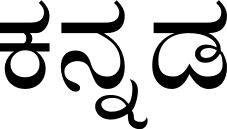Language/Kannada/Vocabulary/Everyday-Actions
| ◀️ Basic Verbs — Previous Lesson | Next Lesson — Present Tense ▶️ |
As a Kannada language teacher for over 20 years, I know that learning verbs related to everyday actions can greatly help beginners grasp the language's foundation. In this lesson, you will learn common verbs related to daily activities such as eating, drinking, sleeping, and working.
Take a moment to explore these relevant pages as you conclude this lesson: Meals and Ingredients & Countries (deshagalu).
Basic Verbs[edit | edit source]
Before we dive into everyday actions, it's essential to learn basic verbs such as 'to be,' 'to have,' 'to go,' and 'to do.' Here's a table of a few basic verbs to get you started:
| Kannada | Pronunciation | English |
|---|---|---|
| ಇದೆ (ide) | [ɪd̪ɛ] | to be (present tense) |
| ಇಲ್ಲ (illa) | [ɪll̪ə] | to be (negative) |
| ಹೇಳು (hēḷu) | [heːɭʊ] | to say/tell |
| ಕೊಡು (koḍu) | [koɖʊ] | to give |
- Note: In Kannada, verbs have a root form, and they are conjugated based on tense, gender, and number.
Everyday Actions[edit | edit source]
Let's learn verbs related to everyday actions. Here are some common actions and their corresponding verbs in Kannada:
| Kannada | Pronunciation | English |
|---|---|---|
| ತಿನ್ನು (tinṇu) | [t̪ɪnːu] | to eat |
| ಕುಡಿ (kuḍi) | [kuɖi] | to drink |
| ಮಲಗು (malagu) | [məɭəgu] | to sleep |
| ಹೊಸಗು (hosagu) | [ho̞səɡʊ] | to wake up |
| ಕೆಲಸ ಮಾಡು (kelas maadu) | [keɭəs mɑːɖʊ] | to work |
| ಬೋಧಿಸು (bōdhisu) | [boːd̪ʱisu] | to teach |
| ಕೇಳು (kēḷu) | [keːɭʊ] | to listen |
Now you can try forming some simple sentences in Kannada with these verbs! For example, "ನಾನು ಊಟ ಮಾಡುತ್ತಿದ್ದೇನೆ" (Naanu uṭa maḍuttiddene) means "I am eating," and "ನಾನು ಕೆಲಸ ಮಾಡುತ್ತೇನೆ" (Naanu kelas maḍuttēne) means "I am working."
Overall, learning everyday action verbs will help you understand and communicate in Kannada better. Stay tuned for more lessons in the “Complete 0 to A1 Kannada Course” to further develop your knowledge!
Other Lessons[edit | edit source]
- Travel Phrases
- Meals and Ingredients
- Express Surprise
- Count to 10
- Feelings and Emotions
- Drinks
- Describing Places
- Modes of Transportation
- Animals
- Countries (deshagalu)
Sources[edit | edit source]
- English to Kannada Translator - Apps on Google Play
- balake kannada-1.pdf
- English Kannada Dictionary - Apps on Google Play
| ◀️ Basic Verbs — Previous Lesson | Next Lesson — Present Tense ▶️ |

